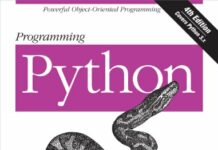
Ebook Info
- Published: 2014
- Number of pages: 359 pages
- Format: PDF
- File Size: 4.96 MB
- Authors: Mark Lutz
Description
Updated for both Python 3.4 and 2.7, this convenient pocket guide is the perfect on-the-job quick reference. Youâ??ll find concise, need-to-know information on Python types and statements, special method names, built-in functions and exceptions, commonly used standard library modules, and other prominent Python tools. The handy index lets you pinpoint exactly what you need.Written by Mark Lutzâ??widely recognized as the worldâ??s leading Python trainerâ??Python Pocket Reference is an ideal companion to Oâ??Reillyâ??s classic Python tutorials, Learning Python and Programming Python, also written by Mark.This fifth edition covers:Built-in object types, including numbers, lists, dictionaries, and moreStatements and syntax for creating and processing objectsFunctions and modules for structuring and reusing codePythonâ??s object-oriented programming toolsBuilt-in functions, exceptions, and attributesSpecial operator overloading methodsWidely used standard library modules and extensionsCommand-line options and development toolsPython idioms and hintsThe Python SQL Database API
User’s Reviews
Reviews from Amazon users which were colected at the time this book was published on the website:
⭐I believe this book is free in PDF format (Do a google search). But the paper copy is nice to throw in your backpack or have at your computer when you want to check a syntax or concept point in Python. It’s a nice, compact review/cheat sheet. I would buy this again.
⭐I am a software developer with 40+ years experience and have worked with many different languages and environments over the years. A new project I started working required that I use Python which I knew very little about. I bought this book thinking that the quickest way to learn Python would be to get a concise reference and look up things I needed to know. This has worked for me in the past in other situations.Unfortunately, this book is not what I needed. It is not complete enough for me to learn Python little by little. Here are some of the deficiencies I found:- I wanted to know how to format text with parameter substitution. Looked for “{” or “}” in the index, but they were not there.- I saw the “pass” command in one of the examples and wanted to find out what it did. It is not listed in the index, and I could not find a description of it by thumbing through the book.- I wanted to read about the string “replace” function. It is not referenced in the index.- I wanted to find out how to determine the length of a list. Nothing discussed about this in the section on lists.Perhaps when I learn more about Python this skimpy reference book will become useful, but for a Python beginner, I fond it sorely lacking. After hitting a wall several times, I decided to shelve this book and get a more complete one.(By the way, I don’t think Mark Lutz is a bad author. The book I bought to replace this one was “Learning Python” by Mark Lutz. It has been really good so far, although at 1600 pages, it is probably more than I need.)
⭐I bought this book thinking it would be an invaluable companion in my quest to learn computer programming. While it is definitely written well and potentially worth the money, I never ended up actually using it. Any information I needed on Python was only a few key strokes away. Searching things on Google was much quicker than looking up things in this book, so it just gathered dust until I gave it away.
⭐I’m learning Python but I already program in a few languages, so I wasn’t sure I needed the big “Intro to this Language in great Detail!” book. I ordered this one instead and it’s become my constant companion on my Python journey. It’s exactly what I wanted when I need to look up the syntax or function I know exists but don’t know exactly how to format in this new language. I’m learning python to play with the Raspberry Pi, not for any professional reasons, so YMMV.I can’t rave about this pocket reference enough. It’s the greatest. I’ve been through quite a few, even other O’Reilly pocket references, and while they’ve all been helpful to some extent, I was never able to teach myself an entire language from a pocket reference. I don’t think that’s a thing that would work if you’ve never programmed before, but if you’re already a programmer and you’ve just decided to add Python to your repertoire, skip the big book and stick this one in your desk drawer instead. Between it and google you’ll be fine.
⭐I refer to this frequently as I am learning Python and it usually gives me the answer but sometimes it takes quite a bit of searching and flipping back and forth. So I think the index and/or organization could be a little better. Some examples:* If you are trying to look up a concept but you don’t know Python’s word for it, alternate words likely won’t get you there.* Suppose you want to copy an object, or assign the contents of one object to another, and you’re trying to find the Python way to do that. The index does not have entries for “copy” or “contents”. It does have an entry for “assignment statement” but that will just assign an object’s reference to another variable so now you have two variables pointing to the same object. What you’re looking for is under “slicing” but how would you find that unless you already knew it?A few more details / examples wouldn’t hurt either although I understand they are trying to keep a “pocket” reference small.
⭐I have used this book sparingly over the past 6 months, and I code as a hobby not a living. It has a lot of useful information regarding the Python language including pointing out differences between versions 3.4 and 2.7. The book is written for someone who has an in-depth knowledge of computer science, and although I have a degree in such a field, I have only started using Python upon buying this book so some terms were difficult to understand even for me. As the title of the book states, it is a reference, not something to be read in the evening.
⭐Perfect.
⭐Helped me get by with python in the beginning.I actually went and read about two-thirds of the book before I started to use it as a reference book.Within a couple of weeks, I was writing code to throw API calls to a web service to integrate some data between an ERP system.Python is actually a really awesome language. I mostly use it for small server-side projects, and this book will provide the information you need for that. For GUI type applications, you will have to find other reference. There are some good tutorials on YouTube to get you up and going… try searching for wxPython or TkInter tutorials.
⭐Whilst this is an excellent book in printed format, it is unusable in Kindle. You cannot easily find what you are looking for, and pages are hard to read.
⭐Good pocket guide, it does not cover everything so you will still need to use good ole Google. But is a good guide worth having.
⭐all good thanks, good reface book.
⭐A great pocket guide to debugging python code. Many reference points in here which is useful for quick searching for solutions.
⭐Elegant sufficiency!
Keywords
Free Download Python Pocket Reference: Python In Your Pocket (Pocket Reference (O’Reilly)) 5th Edition in PDF format
Python Pocket Reference: Python In Your Pocket (Pocket Reference (O’Reilly)) 5th Edition PDF Free Download
Download Python Pocket Reference: Python In Your Pocket (Pocket Reference (O’Reilly)) 5th Edition 2014 PDF Free
Python Pocket Reference: Python In Your Pocket (Pocket Reference (O’Reilly)) 5th Edition 2014 PDF Free Download
Download Python Pocket Reference: Python In Your Pocket (Pocket Reference (O’Reilly)) 5th Edition PDF
Free Download Ebook Python Pocket Reference: Python In Your Pocket (Pocket Reference (O’Reilly)) 5th Edition

